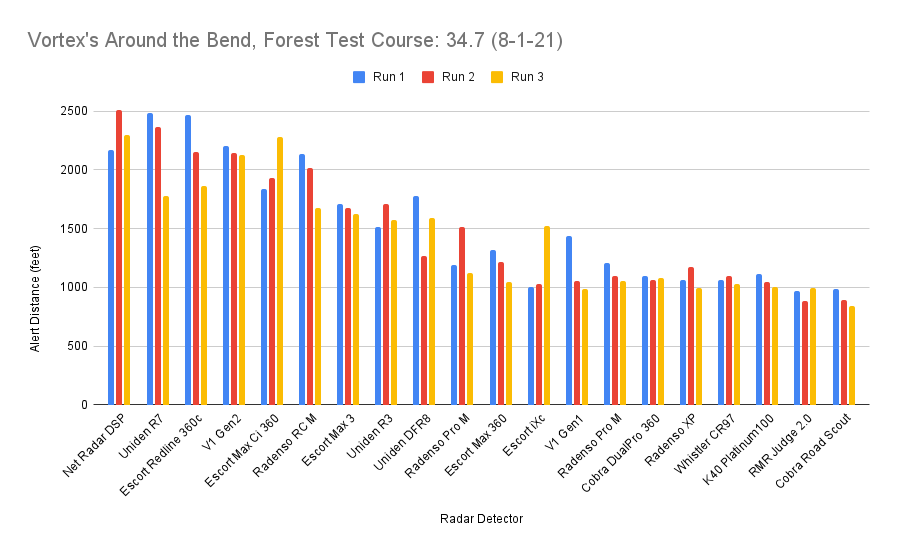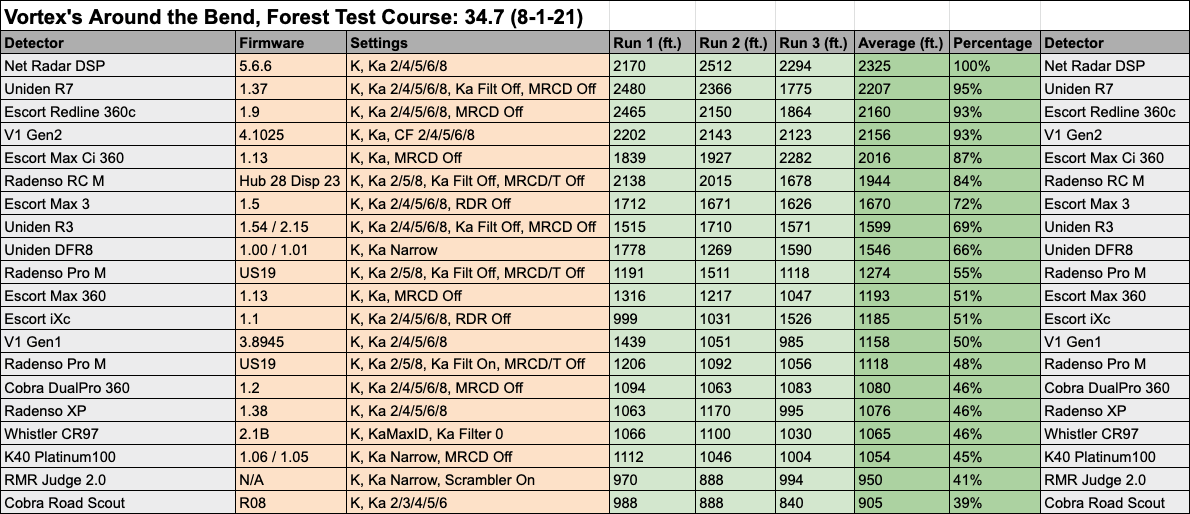This weekend I set out to test a bunch of radar detectors in a very difficult situation we encounter up here in Washington: officers hiding behind a bend shoot radar with trees blocking long range detection. The test course we set up was very challenging and helped separate higher end detectors from the weaker detectors.
Test Course
Here’s our test course:

The kill zone was about 560 ft. away. You round the bend and as soon as you can see the officer, he locks in your speed.
Here’s a run with the Uniden R3 so you can see the test course. (I muted parts of the audio for the drive or from the radar gun to make things clearer.)
Traffic was very light, though sometimes it did seem to affect the results. Sometimes the detectors did a little worse when there was a car in front of the radar gun, maybe because the car blocked some of the radar signal. Other times the detectors did a little better, maybe because a car helped reflect some signal around the bend and down range to the detector. Because of this, we did multiple runs per detector.
Every detector was configured the same: latest firmware, X off, K on, Ka 2/4/5/6/8 when available, 2/5/8 otherwise, Ka filters off (except for testing both on and off with the Pro M), and MRCD/CT off. There were some bad runs we discarded and reruns that we did for various reasons, 92 test passes total over 7 hours, lol. I brought 3 radar guns and we only had time to run 1.
Test Results
Without further ado, let’s get into the results and some discussion regarding the rankings of different detectors, including important things we learned that you won’t see in the test charts:

Longest Range Detectors
Here were the best performers able to alert over 2,000 feet away:
We ran the course at 45 MPH (PSL). At that speed you’d have a full 22 sec before entering the kill zone, impressive for a very challenging situation. (Lower end detectors gave just a few seconds of warning which may not be enough if you’re driving faster than the limit and especially if the officer is using instant on…)
The Net Radar DSP managed to be the top performer in this test which was extremely impressive. Strangely the first detection it gave was only 717 feet (not shown). Something was very wrong so I double checked my antenna connections and power cycled (I normally drive with the NR DSP unplugged and I plugged it in just before starting the test passes). After that it was a beast.
All of these detectors did an excellent job of picking up the officer ahead with plenty of advanced warning to spare.
Second Tier of Detectors
The next group of detectors also did really well giving 1500+ ft. of warning, or 14+ seconds of warning against C/O if driving at PSL. These detectors are:
The R3 did excellent as expected. It was the first detector we tested and its first run was 2288 feet. That alert was soon after we hopped onto the road to start the run and we figured we needed a longer course so we aborted the run and went back further so we could drive the course at speed. The rest of the alerts were shorter. Like we’ve seen with previous tests, the faster you drive, the harder it is for detectors to pick up brief weak blips of radar at a distance.
The Max 3 did well too, though its rampup was weird on one of the runs.
The DFR8 also did surprisingly well, but that platform is usually especially strong on 34.7. The DFR8 and DFR9 punch above their weight class against Stalker radar guns and it’s part of why I like them as budget options.
Third Tier of Detectors
The next group of detectors gave later warning, around 1200’ish feet, and this starts to get down to the bottom of my comfort level. That’s less than 10 sec when doing PSL. Driving faster and/or facing I/O makes things tougher. In this group we’ve got:
With the Pro M, I did 3 passes with Ka filter enabled and 3 with it disabled. (I normally run the Pro M with Ka Filtering enabled for reduced Ka falses.) This time it did a little better overall with the filter disabled.
The iXc had two ~1000 ft runs and one longer ~1500 ft run. It also sometimes had a weird rampup. I was curious how it compared to the Max 3 and it looks like the newer Max 3 is a stronger performer, at least in this test.
The V1 Gen1 was similar in range to the iXc. Rampup was definitely better than the Escort, but it’s a big difference compared to the V1 Gen2. No surprise there.
Detectors in this range may be able to skate by in tough situations, but some of your saves may be cutting it a little close in terms of advanced warning.
Fourth Tier of Detectors
This group of detectors all alerted around 1,000 feet, or just over 6 sec of warning at PSL. That’s getting too close for comfort, IMHO. These detectors include:
The DP360 performed pretty similar to the Max 360 overall. Neither were mindblowing, but maybe my Max 360 is slightly more sensitive than my DP360.
The XP performed about how I expected.
The CR97 had one detection where it failed to alert at all, but it alerted properly on the other passes. After we finished, we realized we were using the K40 power cable by mistake. Whoops! So we threw out all those runs and reran the Whistler with the proper cable just to avoid any issues due to using a different brand of power cables. (I brought at LOT of different power cables this time and need to make sure I label them next time so they’re easier to find, lol.)
The K40 Platinum100 surprised me. It shares the same platform as the DFR6/7/8/9 so I was expecting it to do better against 34.7, but maybe something about K40’s tuning hampered its range. I dunno. I’ll be doing a video on this detector because it’s got some additional features compared to the Uniden, but as usual, the K40 looks to be an overpriced underperformer.
After seeing the test results, I wouldn’t choose to run any of these detectors in challenging situations.
Bottom Tier of Detectors
Finally in last place we had detectors that alerted in the 800-900ish ft. range:
Funny story about these two…
So I ordered the new RMR Odin direct from RMR about a week ago to get it for this testing. They shipped it, but never sent me a shipping confirmation. I had it shipped to a PO Box I basically never use and they didn’t give me a package received notification either so I had no idea it arrived, lol. So I tested with the Judge instead which is the same thing, performance-wise. The Odin just adds a USB power port and Bluetooth. Range should otherwise be the same.
As for the Road Scout, this is a brand new unit. I’ve done a couple tests with it in the past and it’s performed poorly (red barn testing, Ka I/O testing, K I/O testing). I was particularly concerned after the I/O test results so after the test I sent the detector in for repair. Apparently they don’t repair the Road Scout so they just replaced it with a new unit. So I tested with a brand new unit for this test and it again turned in bottom of the barrel results.
Results Not Shown
I also tested the Stinger VIP. Unfortunately though it kept throwing antenna communication errors and then antenna disconnected errors. When it was able to detect, it gave extremely poor distances: 1013, 924, 979. I tried power cycling, reseating the cables, and removing the plastic foglight panel in front of my antenna, but the system kept alerting at the same spot every time. With all the errors and issues I encountered, I decided to drop the Stinger from the final chart, but I’m mentioning it here.
Overall Conclusions
So this was a really tough test course. The very best detectors were able to provide nearly half a mile of advanced warning which I find extremely impressive considering all the trees in the way, the huge hill between the radar gun and the straightaway, and the hill you drive up that blocks signals coming in from ahead.
When driving through the mountains we have here, I’d prefer to run a detector from the first or second tier of detectors and I’d avoid anything else.
The lowest end detectors didn’t get C/Owned. I was honestly expecting some of them to, so kudos for managing to avoid doing that. Had we been driving faster, it may have been a different story. (There was a dog that would run into the street chasing cars at the beginning of the test and I almost hit him on one pass. There was also a Sheriff that drove through our course and stopped in the middle of it after a full day of testing, but luckily it was about something else other than the car that kept driving back and forth down this stretch of road all day long, lol. I suppose testing driving faster than PSL would be insightful, but I tested at PSL and you can do the math for different speeds.)
Finally a huge thank you to @ferius for helping make this test possible, along with his phenomenal RD test app!
For full discussion about this test, check out the testing thread on RDF.
| This website contains affiliate links and I sometimes make commissions on purchases. All opinions are my own. I don’t do paid or sponsored reviews. Click here to read my affiliate disclosure. |



6 comments
Skip to comment form
Great real life review. This is exactly the kind of info that people need when selecting a detector based on performance rather than additional features. I was a bit surprised that the R7 did so much better than the R3, although the R3 is still plenty solid.
Great test that really helps with understanding the difference between weak, good or Great detectors.
I assume using 33.8 or 35.5 at the same course will show some more differences between the detectors as each detector shines better on specific bands.
360c
V1 gen2
R7
Are beasts
Thank you very much Vortex
In previous red barn tests the V1 gen2 is a little weaker on 34.7 so no surprises on this test.
On 33.8 & even more noticeable on 35.5 the v1 gen2 is much better & still it did very well on 34.7 which is the only band that was tested here.
Great test
Good review, very informative. I always like the 3 runs as I look at the average.
Hi Ariel,
FYI…Uniden has a new Radar model DFR9BLK, same as the DFR9, but with a new rubberized matte black finish, Amazon = https://www.amazon.com/gp/product/B0912DH9D9
I looked at the link from Hans. I noticed that the R1 is almost $50 more than the R3 on Amazon. What is up with that? Is there much difference between this new DRF9 and an R3?